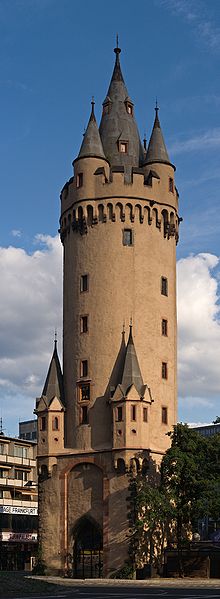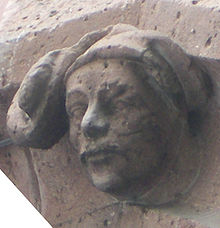Eschenheim Tower
The Eschenheimer Turm was a city gate of the late medieval Frankfurt city fortifications of Frankfurt am Main and is a landmark of the city. In Frankfurt Neustadt, which was largely shaped by post-war architecture for historical reasons, better known today as Frankfurt City Center , the tower, built at the beginning of the 15th century , is also the oldest and at the same time almost completely preserved building in Frankfurt city center.
history
Prehistory and topographical classification
At the beginning of the 14th century , the development of Frankfurt's old town gradually reached its limits. Mentions of individual buildings before the protective, around 1200 built Staufenmauer in the 1320s attest years, how much new building for the fast-growing free city was necessary. With the permission of Emperor Ludwig IV , the so-called second city expansion took place in 1333 , which tripled the area of the city and pushed forward to the inner boundaries of the ramparts , which are still clearly visible in the aerial photograph . Just ten years later, in 1343, the construction of a new city wall , also approved by the emperor , began to protect the new part of the city , simply called Neustadt , against the dangers that were constantly threatening in those years. Apart from the Zeil , the location of the cattle market , and the Rossmarkt , for centuries it was characterized more by gardens and agricultural use than by civil development .
Although the entire new defensive system over 100 years of construction took to complete, is already three years after construction began at least advanced in the northwest part so far that on 11 October 1349 cornerstone for a first, only as a "round" designated gate tower at the Place of the later Eschenheimer tower could be placed. Located at the exit of Grosse Eschenheimer Strasse , which represented the urban extension of the Kornmarkt , the most important north-south tangent next to the Fahrgasse , a fortification at this point was also of the utmost strategic importance. Since expenses for a tower watchman were already recorded in the municipal accounting book of 1348 with “Contze uff Essirsheimer Porten” , the construction of the tower must have been completed after two years at the latest, and Lersner's statements, which otherwise do not meet the requirements of sources, can also be made on this point convince.
From 1400 the carpenter Klaus Mengoz finally built a replacement for the first gate tower. The Frankfurt cathedral master builder Madern Gerthener completed it in 1426-1428. When the city walls on 1806-1812 Prussian instigation canceled and the ramparts was replaced, and the Eschenheimer tower as any other gate buildings should be demolished. At the objection of the envoy of the French occupying power at the time , Count d'Hédouville , it, the most famous of around 60 towers of the city fortifications, remained as a memorial. Apart from the Eschenheimer Tower, only two other towers, the Rententurm on Römerberg and the Kuhhirtenturm in Alt-Sachsenhausen , escaped demolition.
architecture
The Eschenheim tower is 47 m high and has eight full and two attic floors. A round tower rises above a square base, the actual gate . The steep top of the tower is accompanied by four small, equally proportioned crowd watch towers , around them a cantilevered battlement .
The master builders could have used the Adolfsturm in the neighboring imperial city of Friedberg , which was built in 1347 and which has a similar layout, as a stylistic model . Originally under a Gothic arch through it, now the Große Eschenheimer Straße runs around it , which continues outside the former fortifications in the Eschersheimer Landstraße . The passage could be closed with a drop gate. Earth and stones were stored on the first floor in order to additionally block the passage in the event of an attack. The second floor lies behind 2.50 m thick walls parlor of the tower monitor which was occupied until the 1956th Both sides of the tower have heraldic reliefs at the level of the second floor: on the city side the silver eagle on a red background, the coat of arms of the Free Imperial City and on the land side the black double-headed eagle on a gold background, the coat of arms of the empire .
On the city side there is a covered balcony over the passage, on the land side there are two small flank turrets. A portrait relief above the entrance to the restaurant on the city side probably represents the builder Gerthener himself.
On the top of the tower is an iron weather vane into which , according to the legend “ The nine in the weather vane ”, the poacher Hans Winkelsee , who was sentenced to death and imprisoned in the tower, shot a perfect 9 with nine shots . The art shot is said to have impressed the city council so much that it pardoned Winkelsee. The holes in the weather vane are easy to see, but today it is no longer the same weather vane.
In the tower, large parts of the original staircase and the intermediate floors from the period from 1426 to 1428 have been preserved.
description

Today the tower stands in the middle of a spacious, very busy square, called Eschenheimer Tor .
Under the Eschenheimer Tor there is a subway station built between 1963 and 1968 , the tunnel of which leads directly past the foundations of the tower. The mezzanine level of the underground station was at times the only way to cross the square as a pedestrian or to reach the tower. Since 1992, the Eschenheimer Turm, which stood on an inaccessible traffic island for decades , has been accessible again from the pedestrian zone Schillerstrasse. Since then, there has been a bar with a restaurant on the ground floor , and the tower guard's fireplace room is also used by the catering establishment. In addition, until December 2010 there was an event organized by the Friends of Frankfurt e. V. took place in the fireplace room, where the former resident of the tower Ruth Schwarz reported on the history of the tower. It was also possible to visit the tower up to the level of the battlement . Ruth Schwarz from the Friends of Frankfurt Association initiated the last renovation of the tower in 1992.
Following the example of the Eschenheimer tower was 1853-1856 in the castle park Babelsberg in Potsdam the Flatow tower built.
The Eschenheimer Turm is part of the company logo of the former Henninger Bräu AG , today as the logo for Henninger Kaiser Pils in the Radeberger Gruppe KG .
gallery
See also
- Eschenheimer Tor
- The nine in the weather vane
- Friends of Frankfurt - Association for the maintenance of the Frankfurt tradition
Web links
- The Eschenheim Tower. altfrankfurt.com
- State Office for the Preservation of Monuments Hesse (ed.): Eschenheimer Turm In: DenkXweb, online edition of cultural monuments in Hesse
- Tower Bar & Restaurant in the Eschenheimer Turm
literature
- August von Cohausen: Contributions to the history of Frankfurt in the Middle Ages , in: Archive for Frankfurt History and Art, Vol. 12, self-published by the association on commission from Heinrich Keller, Frankfurt am Main 1869, pp. 21–56.
- Rudolf Jung, Carl Wolff: The architectural monuments of Frankfurt am Main - Volume 2, Secular buildings . Self-published / Völcker, Frankfurt am Main 1898, pp. 26–41.
- Bettina Maierhofer: The smallest tower with the longest history. Conscious of tradition with a wink. The Eschenheimer Turm is the oldest high-rise in the city and is part of the Skyscraper Festival for the first time . In: Frankfurter Allgemeine Sonntagszeitung (special supplement Skyscraper Festival) . May 6, 2007, p. B10.
- Carl Theodor Reiffenstein: The landmarks of Frankfurt a. M. , in: Archive for Frankfurt's History and Art, Vol. 9, self-published by the association on commission from Heinrich Keller, Frankfurt am Main 1860, pp. 288–291.
- Ruth Schwarz: The Eschenheim Tower. A landmark of Frankfurt . Verlag Waldemar Kramer, Frankfurt am Main 2001, ISBN 978-3-7829-0517-6 .
- Wolf-Christian Setzepfandt : Architecture Guide Frankfurt am Main . 3. Edition. Dietrich Reimer Verlag, Berlin 2002, ISBN 3-496-01236-6 , p. 8 .
References and comments
- ↑ "Ruth Schwarz says goodbye to her" Törmsche "" ( page no longer available , search in web archives ) Info: The link was automatically marked as defective. Please check the link according to the instructions and then remove this notice. , Article of November 30, 2010, 9:59 p.m. (last change December 1, 2010, 4:08 a.m.) on fnp.de.
- ^ Website of the Friends of Frankfurt - Association for the Care of Frankfurter Tradition e. V.
- ↑ Ruth Schwarz: The Eschenheimer tower. A landmark of Frankfurt . Verlag Waldemar Kramer, Frankfurt am Main 2001, ISBN 978-3-7829-0517-6 .
Coordinates: 50 ° 7 ′ 1 ″ N , 8 ° 40 ′ 47 ″ E













